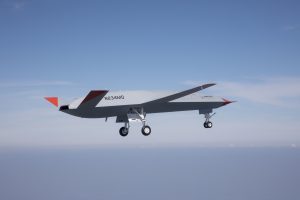Drone aircraft refueler makes maiden flight
By Bob Pieper for Chronicle Media — October 7, 2019
The first MQ-25 drone, known as “Tail 1” or “T1,” completed the two-hour flight under the direction of Boeing test pilots at MidAmerica, where the test program is based. (Photo courtesy of the Boeing Corporation)
In what aviation and military experts are calling an historic first, a first-of-its-kind drone, designed to refuel other aircraft in mid-air, was successfully test flown, Sept. 19 by the Boeing Company and U.S. Navy at MidAmerica St. Louis Airport in Mascoutah.
Destined to become the first unmanned aircraft ever used on aircraft carriers, the Navy’s MQ-25 Stingray drone represents a significant development in military technology; with potential to markedly expand the range of U.S. fighter jets, according to the Navy.
Eventually, development of the refuelers will lead to deployment of carrier-based bomber, fighter, and surveillance drones, military experts say.
Last month’s test represents a landmark in the Pentagon’s push toward more automated operations, Navy officials say.
“The MQ-25 was really a signature program to test the limits and plow new ground in that direction,” Adm. John Richardson told Defense News in April.
The first MQ-25 drone, known as “Tail 1” or “T1,” completed the two-hour flight under the direction of Boeing test pilots operating from a ground control station at MidAmerica, where the test program is based.
The drone completed an autonomous taxi and takeoff at the airport and then flew a predetermined route to validate the aircraft’s basic flight functions and interoperability with the ground control station, according to a Boeing statement.
The statement did not specify the distance the drone travelled, the route of the test flight, or other specifics.
Boeing is scheduled to deliver the first MQ-25 to the Navy for testing aboard carrier in 2021. The Navy wants delivery of the first production model MQ-25 in two years; with an eye toward deployment in 2024.
The Navy plans to deploy as many as 76 of the drones on carriers by the mid-2020s.
Presently scheduled testing of the drone will be devoted to “further early learning and discovery that advances major systems and software development,” according to a prepared statement from the aircraft builder.
Neither Boeing nor the Navy publicly announced when the drone might be first tested for in-air refueling.
Boeing is producing four experimental MQ-25s under an $805 million development contract awarded by the Navy in August 2018.
The first, T1, was granted an experimental airworthiness certificate by the Federal Aviation Administration (FAA) last month; verifying that the air vehicle meets the agency’s basic requirements for safe flight.
While unheard-of in private or commercial aviation, mid-air refueling has been a routine part of military air operations since the Vietnam War. Today, it generally involves the transfer of fuel from an airborne tanker, through an extended pipe or “probe,” to a fighter or bomber.
The technique effectively extends the range of aircraft; facilitating long-range bombing and surveillance missions.
It is essential to the U.S. practice, instituted during the Cold War, of keeping strategic bombers, armed with nuclear weapons, aloft 24-hours-a-day as a conflict deterrence strategy, military historians note. However, it is also required for many other types of long-range
The U.S. Air Force’s 108th Air Refueling Squadron is headquartered at Scott Air Force Base, adjacent to Mid-America Airport. Mascoutah area residents for years have been able to see tankers and fighters practicing in-air refueling overhead.
Drones, now operated out of U.S. air based around the world, have been an important part of American military operations for years.
However, the successful development of carrier-based drones, which can refuel other aircraft, marks a significant advancement, the Washington Post noted in coverage of the MQ25 program.
Air superiority is considered a cornerstone of U.S. military superiority worldwide, the newspaper observed.
However, improved defenses, notable in China, are increasing force U.S. carries further offshore from many hostile nations; often placing such nations out of the range of carrier-based aircraft.
Carrier-based refueling drones would effectively putting many targets back in range, military analysts note.
The Navy successfully landed a drone, the X-47B UAV, on an aircraft carrier for the first time in July 2013; following a takeoff from the carrier George H.W. Bush and brief flight off the coast of Virginia.
Originally, the MQ-25 development program was to include strategic and surveillance craft; however, Navy officials opted to scale back the effort to include only refuelers.
The drones are being designed and built under an expedited development program, at Boeing’s St. Louis County military aircraft production facility, adjacent to St. Louis Lambert International Airport.
The prototype, roughly the size of a Boeing F/A-18 Super Hornet fighter, was, in April, moved to MidAmerica by truck for flight testing. Officials cited the advantages of conducting drone tests in the less crowded airspace around the smaller, regional airport.
Ground control stations for the drones have been installed at MidAmerica. The company has not indicated what role its Boeing St. Clair plant, opened at MidAmerica Airport in 2011, might play in the drone program.
The St. Clair facility currently performs assembly work on F/A-18s, as well as assembly and subassembly on the C-17 Globemaster III transport planes and CH-47 Chinook helicopters; employing about 75 workers.
The $805 million agreement for the four MQ-25 test drones was important to Chicago-based Boeing, which, industry analysts note, has been passed by for several major military contracts over recent years.
In addition to Boeing, General Atomics and Lockheed Martin, submitted bids for the drone development contract in January of last year.
Boeing now hopes to secure the contract for production of the MQ-25 drones, which is expected to run through 2022.
The Navy has not yet released the cost of the entire MQ-25 project. However, some industry analysts estimate the production cost of all 75 drones at $3 billion.
That is potentially good news for the St. Louis area labor market. North St. Louis County has suffered prolonged economic and population declines due to cutbacks at Boeing, loss of flights at Lambert International, outsourcing at Emerson Electric in Ferguson and the closing of the area’s Ford assembly plant.
The drone test program is also good news for MidAmerica Airport which has drawn criticism for underutilization and failure to deliver anticipated economic benefits for St. Clair County.
“We’re honored to host Boeing’s MQ-25 flight test operations in addition to the (Boeing) company’s existing St. Clair County manufacturing operations,” said MidAmerica St. Louis Airport Director Tim Cantwell. “It’s also a testament to the unique capabilities we possess with open airspace, expansive aircraft surfaces and our personnel’s commitment to the success of all of our customers.”
Data systems for the drone are being developed by Virginia-based Curtiss Wright Defense Solutions; a company with roots in the pioneering aircraft company that, in the 1920s, established Curtiss Wright Airport in Cahokia, today known as St. Louis Downtown Airport.








